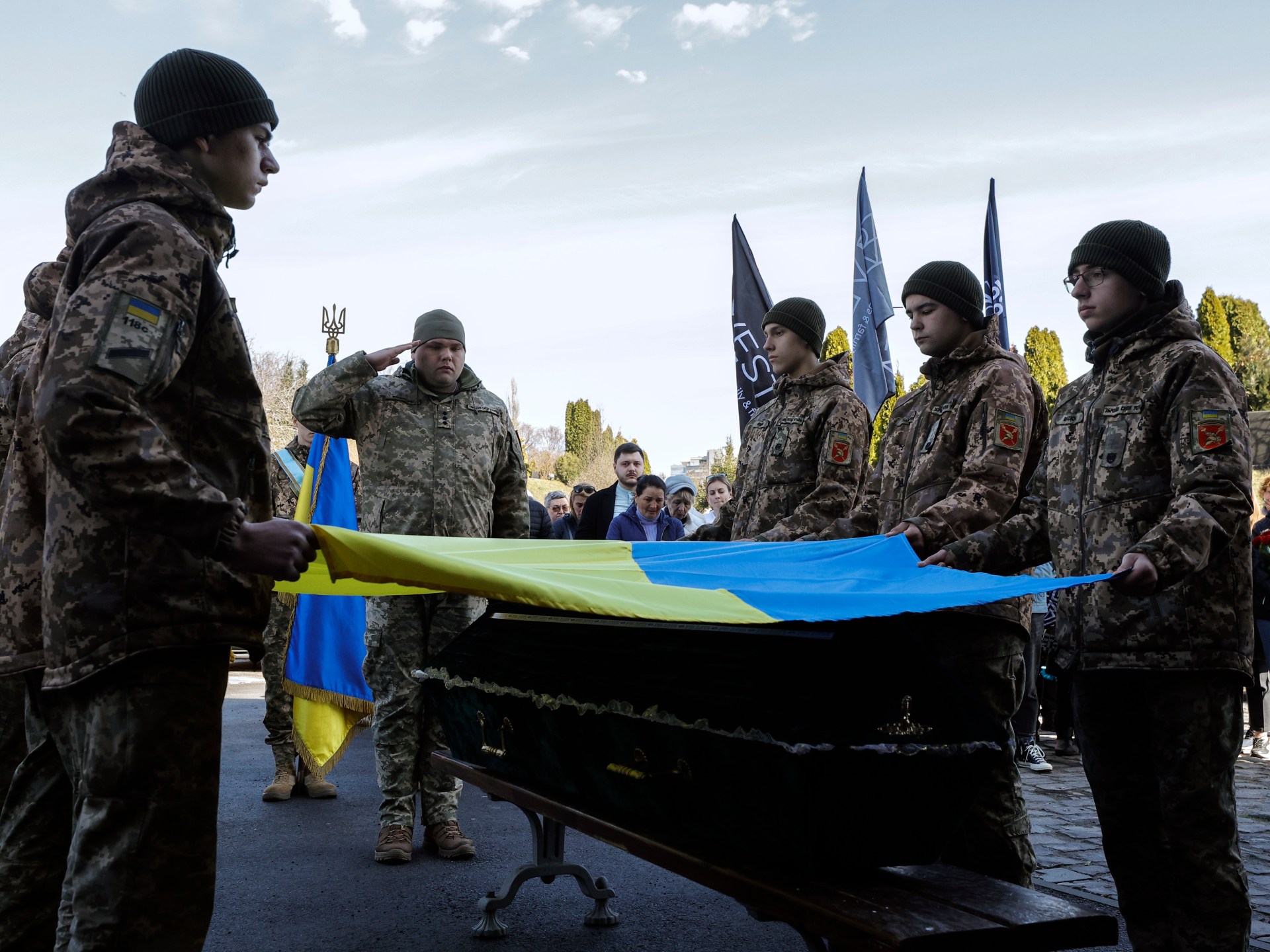The funeral of a Ukrainian soldier killed in the Donetsk region (European)
Along a line extending a thousand kilometers, fierce fighting rages between Russia and Ukraine, but experts know that Russia is prevailing at a critical stage of the war, which has made Ukraine race against time to provide its need for ammunition, especially artillery shells, the primary weapon in the ongoing fighting.
The Spanish newspaper "La Vanguardia" quoted estimates from Western military institutes and centers saying that the Russian army fires 10,000 artillery shells daily, compared to 2,000 shells fired by the Ukrainian army, as acknowledged by its Defense Minister Rustam Umarov.
Lavanguardia says that the scarcity of medium-range missiles - the type that Ukraine currently needs - is harming the war effort at a critical moment when Kiev expects a large-scale Russian attack soon.
The effects of this scarcity became clear on the southern and eastern fronts, and the situation was made worse by the decline in the mobilization effort, which Ukrainian President Volodymyr Zelensky is reluctant to expand for fear of popular discontent.
According to the newspaper, Russia's fire and numerical superiority allowed it to control Avdiivka in the Donetsk region, a town where battles raged even before the start of the Russian war on Ukraine on February 24, 2022, and the Ukrainian army withdrew from it by order of the Supreme Command.
The newspaper says that Kiev is looking forward to a Czech plan to purchase 800,000 shells from countries outside the European Union, and that 18 allied countries, including Germany, Sweden and the Netherlands, have committed to helping finance it.
Ukrainian Prime Minister Denis Shmyhal said during a visit to Luxembourg - last week - that his country is counting on this plan to have sufficient deterrent force starting this month, but his statement seems overly optimistic, according to Lavanguardia, as the purchases are complex, and the Czech Republic does not expect the quantities to be completed. Before next June.
Temporary solutions
The Spanish newspaper adds that time is pressing, and supply routes are either disrupted or slow, as is the case with a US aid package worth $6 billion that remains imprisoned in the US House of Representatives due to Republican members’ objection to it.
Two weeks ago, the White House was forced to approve a donation of $300 million to Ukraine, which was provided from previous purchases. This amount will be directed to purchasing medium-range missiles, but in the end these missiles will only last for a few weeks.
As for the European Union, Ukraine's other major ally, which promised it a million missiles at the end of last March, it will only be able to provide half of them, and it will only be able to deliver 1.1 million missiles by the end of this year, according to its foreign policy official Josep Borrell, who expects that the bloc will be able to produce 1.4 million missiles by the end of the year. 155 mm shells.
Ukraine is secretive about the amount of missiles it manufactures locally, but so far it relies mainly on allied support. According to Jakub Janda, director of the European Values Center for Security Policy, the Czech Republic has revitalized its relations since the period after the collapse of the Soviet Union, when the Warsaw Pact countries inherited huge quantities of weapons, tanks and equipment that they no longer needed and decided to sell them to other countries.
Janda says that the Czech military industry was able, thanks to this previous relationship of trust and at the request of the government, to resume communication with these countries that do not want their names to appear publicly “for fear of Russia and China as well.” Yanda limited himself to referring to countries from the Middle East, Africa, Asia and Latin America.
The newspaper reported that 60% of the 800,000 shells supplied by the Czechs were 155 mm caliber, which are the shells officially approved by NATO and modern Western armies, while 40% were 122 mm caliber, which is the model used in Soviet artillery.
An artillery fight
Artillery shells can reach targets 24 to 32 kilometers away, so ground forces prefer them to attack enemy targets from a safe distance. Jakub Janda says, "Ukraine is in a defensive position now, and what it needs most is artillery."
The war turned into what essentially resembled an artillery battle, and despite the extensive use of drones, missiles, and tanks, 70% of the losses of the two armies were caused by artillery, according to a specialized Italian military magazine.
European estimates indicate that Ukraine needs 357,000 of these missiles per month as a minimum for its operations to be effective, but "the Czech initiative remains a short-term solution until the European industry increases its production."
Yanda says that European arms factories need at least a year to reach the necessary pace to produce enough missiles, "and in the meantime, the war continues, unfortunately."
As for Russia, it needs 4 million shells, but unlike Ukraine, it can - according to the British Royal Institute for Defense Studies - fill the shortage to a large extent, as its military industry is working at its maximum capacity and it may now be able to produce one million artillery rounds annually, according to what the Estonian Army Chief of Staff, Martin Harrim, said. A few weeks ago.
Russia can also obtain ammunition from abroad with relative ease, especially from North Korea, which - according to Ukrainian intelligence - supplied it with one million 122 and 152 caliber shells, the two predominant calibers in Russian artillery.
Source: Spanish press

